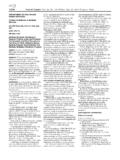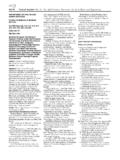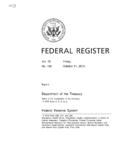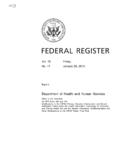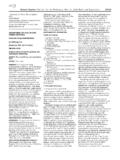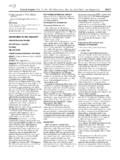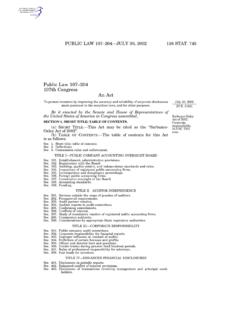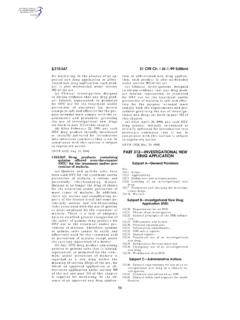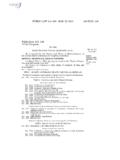Transcription of 45366 Federal Register /Vol. 82, No. 187/Thursday ...
1 45366 Federal Register / Vol. 82, No. 187 / thursday , september 28, 2017 / rules and Regulations DEPARTMENT OF HOMELAND SECURITY Customs and Border Protection DEPARTMENT OF THE TREASURY 19 CFR Parts 4, 10, 18, 19, 113, 122, 123, 141, 142, 143, 144, 146, 151, and 181 [USCBP 2012 0002: CBP Dec. 17 13] RIN 1515 AD81 Changes to the In-Bond Process AGENCY: Customs and Border Protection, Department of Homeland Security; Department of the Treasury. ACTION: Final rule. SUMMARY: This final rule adopts, with several changes, proposed amendments to Customs and Border Protection (CBP) regulations regarding changes to the in-bond process published in the Federal Register on February 22, 2012. The in-bond process allows imported merchandise to be entered at one port of entry without appraisement or payment of duties and transported by a bonded carrier to another port of entry or other authorized destination provided all statutory and regulatory conditions are met.
2 At the destination port, the merchandise is entered or exported. The changes in this rule, including the automation of the in-bond process, will enhance CBP s ability to regulate and track in-bond merchandise and ensure that in-bond merchandise is properly entered or exported. This document addresses comments received in response to the proposed rule and makes several changes in response to the comments that further simplify and facilitate the in-bond process. DATES: This rule is effective on November 27, 2017 . FOR FURTHER INFORMATION CONTACT: James Swanson, Director, Cargo Security and Controls, Cargo Conveyance & Security, Office of Field Operations, (202) 325 1257. SUPPLEMENTARY INFORMATION: Table of Contents I. Background A. Notice of Proposed Rulemaking B.
3 Summary of Main Changes From NPRM 1. In-Transit Time for Merchandise Transported by Barge 2. Uniform Timeframe for Report of Arrival, Notice of Export, and Other Events 3. Description of the Merchandise 4. Reporting the Quantity of In-Bond Merchandise 5. Divided Shipments 6. Clarification of the Term Bonded Carrier 7. Transfer (Transshipment) From One Conveyance to Another 8. Seals Transportation of Bonded Merchandise With Non-Bonded Merchandise 9. Other Changes C. Flexible Enforcement Period II. Discussion of Comments A. Comments Regarding This Rulemaking Generally 1. Elimination of In-Bond Types 2. Scope 3. Outreach 4. In-Bond Shipments Between the United States and Canada B. Electronic Filing and Processing of In- Bond Applications 1.
4 Filing the In-Bond Application 2. Elimination of the CBP Form 7512 3. Information Required 4. Updating and Amending the In-Bond Record 5. Who May File 6. Licensed Customs Brokers 7. Unauthorized Use of a Bond 8. Procedures 9. Change of Foreign Destination C. New Information Requirements for In- Bond Shipments 1. New Information Requirements Generally 2. Special Classes of Merchandise 3. Quantity 4. Location of the Merchandise 5. Destination D. In-Transit Time 1. In-Transit Time Generally 2. In-Bond Shipments Transported by Barge 3. Extension of In-Transit Time 4. Shortening of In-Transit Time 5. Start of In-Transit Time 6. Procedures 7. Intermodal Transportation 8. Report of Arrival 9. General Order Merchandise E. Transfers F. Sealing of Conveyances and Reporting of Seal Numbers G.
5 Air Cargo H. Liability of the Parties I. Export of Merchandise 1. Reporting Arrival at Port of Exportation 2. Proof of Exportation J. Diversion of Merchandise K. Immediate Transportation L. Divided Shipments and Retention of Goods Within Port Limits 1. Divided Shipments 2. Retention of Goods Within Port Limits M. Potential Impact N. Miscellaneous Items 1. Impact on Inland Ports 2. Supervision of Rail Shipments 3. Textiles 4. Cartmen 5. Carnets 6. Sharing of Information and Confidentiality 7. Definitions 8. Restriction of Immediate Exportation by Truck 9. Express Shipments 10. Automated Broker Interface (ABI) 11. Foreign-Trade Zones (FTZs) 12. Importer Security Filing (ISF) 13. Redelivery 14. Pipelines III. Adoption of Proposal IV. Regulatory Analyses A.
6 Executive Order 12866 Regulatory Planning and Review B. Regulatory Flexibility Act Summary FRFA C. Unfunded Mandates Reform Act of 1995 D. Paperwork Reduction Act V. Signing Authority VI. Regulatory Amendments List of Acronyms and Technical Terms ABI Automated Broker Interface ACE Automated Commercial Environment AMS Automated Manifest System CBP Customs and Border Protection DHS Department of Homeland Security EDI Electronic Data Interchange EIN Employer Identification Number FIRMS Facilities Information and Resources Management System FTZ Foreign Trade Zone GAO Government Accountability Office HTSUS Harmonized Tariff Schedule of the United States ISF Importer Security Filing IE Immediate Exportation IT Immediate Transportation NVOCC Non-Vessel Operating Common Carrier SCAC Standard Carrier Alpha Code SNP Secondary Notify Party T&E Transportation and Exportation VOC
7 Vessel Operating Carrier QP/WP An ABI hosted in-bond system for all modes that allows all parties, carriers and non-carriers, to submit electronic in- bond applications directly to CBP, as well as report their arrival and export. The QP half is the application function, the WP half is the arrival/ export function. I. Background Pursuant to 19 1552 and 19 1553, merchandise may be entered at a port of entry, without appraisement or the payment of duties, for transportation to another port for entry, or for exportation, provided that all statutory and regulatory conditions are met. The applicable regulations governing the transportation of in-bond merchandise under the above authorities are set forth in title 19 of the Code of Federal Regulations (19 CFR), parts 18, 122, and 123.
8 Part 18 covers Transportation in bond and merchandise in transit ; part 122 covers Air Commerce regulations ; and part 123 covers CBP relations with Canada and Mexico. For a detailed discussion of the statutory and regulatory histories, and the factors governing development of these regulations, see the notice of proposed rulemaking (NPRM), Changes to the In-Bond Process, published in the Federal Register on February 22, 2012 (77 FR 10622). Generally, when merchandise reaches the United States, the merchandise may VerDate Sep<11>2014 17:19 Sep 27, 2017 Jkt 241001 PO 00000 Frm 00002 Fmt 4701 Sfmt 4700 E:\FR\FM\ 28 SER245367 Federal Register / Vol. 82, No. 187 / thursday , september 28, 2017 / rules and Regulations be entered for consumption, entered for warehouse, admitted into a foreign trade zone, or entered for transportation in- bond to another port.
9 The focus of this rule is on merchandise that is entered for transportation in-bond. Transportation of merchandise in-bond is the movement of imported merchandise, secured by a bond, from one port to another prior to the appraisement of the merchandise and without the payment of duties. The transportation of in-bond merchandise is frequently referred to as an in-bond movement or shipment. There are three types of in-bond transportation entries: Immediate Transportation (IT), Transportation and Exportation (T&E), and Immediate Exportation (IE). An IT entry allows merchandise upon its arrival at a port to be transported to another port, where a subsequent entry must be filed. See 19 1552 and 19 CFR A T&E entry allows merchandise to be entered at a port for transit through the United States to another port, where the merchandise is exported without the payment of duties.
10 See 19 1553 and 19 CFR An IE entry allows cargo that has arrived at a port to be immediately exported from that same port without the payment of duties. See 19 CFR and A. Notice of Proposed Rulemaking On February 22, 2012, Customs and Border Protection (CBP) published a NPRM titled Changes to the In-Bond Process in the Federal Register (77 FR 10622), proposing to revise the in-bond regulations in part 18 as well as other applicable parts of the CBP regulations. The proposed amendments would change the in-bond process from a paper-dependent process to an automated paperless process, provide CBP with the necessary tools to better track in-bond merchandise to improve security and trade compliance, and address certain weaknesses in the in- bond system identified by the Government Accountability Office (GAO) in a report to Congress dated April 17, 2007 (GAO Report).

